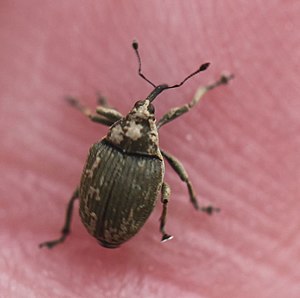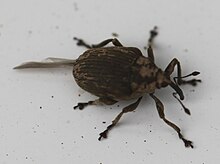Large rape stem weevil
| Large rape stem weevil | ||||||||||||
|---|---|---|---|---|---|---|---|---|---|---|---|---|

Great rapeseed weevil ( Ceutorhynchus napi ) |
||||||||||||
| Systematics | ||||||||||||
|
||||||||||||
| Scientific name | ||||||||||||
| Ceutorhynchus napi | ||||||||||||
| Gyllenhaal , 1837 |
The Great Rapsstängelrüssler or Large cabbage stem weevil ( Ceutorhynchus napi ) is a beetle of the family of weevils (Curculionidae).
features
The beetles are 3.3 to 4 millimeters long and have dark and light gray colored bodies, whereby they are completely covered with gray scales.
The larvae are about seven millimeters long, are yellowish white in color and have a dark head that turns yellowish brown in older animals. They have a characteristic bristle on the top of the head capsule.
Occurrence
The animals are found in central , southern , southern , northern Europe and Turkey . He is unknown in the UK . Also in certain regions of Northern Germany ( Schleswig-Holstein ) or in Western Westphalia it is rarely or not at all to be found.
biology
The larvae feed on cruciferous plants (Brassicaceae), especially winter rape ( Brassica napus ), vegetable cabbage ( Brassica oleracea ), winter cress ( Barbarea vulgaris ), garlic mustard ( Alliaria petiolata ) and watercress ( Nasturtium officinale ).
The rape stem weevil is one of the first weevils to appear as early as March. At 6 ° C soil temperature, it hatches out of the soil where it has overwintered in the cocoon. However, mass immigration of the large oilseed rape weevil into the rapeseed fields only occurs at temperatures of 12 ° C. It flies to new forage plants and the females lay their eggs one by one in the plant stems after a very short period of ripening . Oviposition occurs relatively close to the terminal bud. Rape plants with stems shorter than 20 cm are preferred. If the main shoot of the rapeseed plants is longer, the eggs are laid in the young side shoots. After 1–2 weeks, the eggs develop into larvae that mines in the stem pulp of the plants. The larvae go through three larval stages within 3–5 weeks. At the end of May / beginning of June the larvae are ready to pupate . To do this, they eat a hole in the plant tissue and drop to the ground. The larvae dig about 3 cm deep into the ground and pupate there in an earth cocoon . They overwinter in the earth's cocoon until next spring.
damage
The damage caused by feeding on the leaves of the large oilseed rape weevil is rather insignificant, in contrast to the oviposition of the females, where considerable damage can occur, especially in winter rape. On light soils, the yield losses in dry years can be considerable. Earnings reductions of 25–30% are possible. The stimulus of laying eggs causes deformities of the stem that can tear open lengthways and kink. This happens above all during subsequent frosts or when there is abundant rainfall after periods of drought. In addition to these injuries, the boreholes when the females lay their eggs also offer entry portals for fungal pathogens such as root rot and stem rot ( Phoma lingam ).
Combat
Chemical control of the rape stem weevil by using insecticides from the group of pyrethroids is common. However, it only makes economic sense if the control guideline value for the species has been reached. The guideline control value is based on the number of rape weevils caught in the yellow bowl .
In addition to chemical combat, the appearance of natural opponents is important. The parasitoid Tersilochus fulvipes lays its eggs in the larvae of the rapeseed weevil and thus contributes to the reduction of the population in the following year of cultivation.
Also of importance are predatory ground beetles ( Carabidae ), which eat the larvae of the oilseed rape weevil as soon as they migrate from the oilseed rape plants and drop on the ground to pupate there.
The predatory larvae of the Phaonia trimaculata Bouche fly stalk the larvae of the rape stem weevil and eat them within the rape stem.
Synonyms
Occasionally one also finds the spellings Ceuthorrchynchus and Ceuthorhynchus , but these are spelling mistakes .
Individual evidence
- ^ E Günthart (1949): Contributions to the way of life and control of Ceutorhynchus quadridens PANZ. and Ceutorhynchus napi Gyll. with many observations on other cabbage and rapeseed pests. Communications from the Swiss Entomological Society 23, 441–591
- ↑ R Büchi (1996): Egg-laying of the rapeseed weevil Ceutorhynchus napi Gyll., Depending on the stem length of different types of rapeseed. Scoreboard for malware 69, 136-139
- ^ C Oppermann (1990): Investigations on the occurrence of the rape stem weevil (Ceutorhynchus napi Gyllenhal) on winter rape (Brassica napus L. var oleifera Metzg.) And possibilities of monitoring and control. Dissertation, University of Rostock
- ^ M Landschreiber (2005): The pre-flower pests are still on the advance. RAPS 23, 4-9
- ^ U Krause, B Koopmann, B Ulber (2006) Impact of rape stem weevil, Ceutorhynchus napi, on the early stem infections of oilseed rape by Phoma lingam. IOBC Bulletin 2006 Vol. 7, Proceedings of the Working Group ICOC IOBC Bulletin 2006 Vol. 7, Proceedings of the Working Group ICOC IOBC-Workshop, 327-332, 6
- ^ IH Williams (2004): Advances in Insect Pest Management of Oilseed Rape in Europe. In: AR Horwitz (ed), Insect Pest Management. Springer Verlag, Berlin, 181–208
- ↑ V Garbe, B brooch wit, E Erichsen, R Hoßfeld, G Lauenstein, P Steinbach, B Ulber (1996): damage thresholds in oilseed rape pests. Instruments of an economical winter rapeseed production. RAPS 14, 58-63
- ↑ B Ulber B (2003): Parasitoids of ceutorynchid stem weevils. In: DV Alford (ed), Biocontrol of Oilseed Rape Pests. Blackwell Science, Oxford, 87-95
- ^ W Büchs, DV Alford (2003): Predators of Oilseed Rape Pests. In: DV Alford (ed), Biocontrol of Oilseed Rape Pests. Blackwell Science, Oxford, 181-199
- ^ R Fritzsche (1955): Phaeonia trimaculata Bouché as a parasite of the great cabbage bush Ceutorrhynchus napi Gyll. and Ceutorrhynchus quadridens Panzer of the spotted cabbage bush. Reprint from the newsletter for the German Plant Protection Service 9, 35–36
- ^ DV Alford, C. Nilsson, B Ulber (2003): Insect Pests in Oilseed Rape Crops. In: DV Alford (ed), Biocontrol of Oilseed Rape Pests. Blackwell Science, Oxford, 9-41
literature
- Harde, Severa: Der Kosmos Käferführer, The Central European Beetles. Franckh-Kosmos Verlags-GmbH & Co, Stuttgart 2000, ISBN 3-440-06959-1
- Christian Oppermann: Investigations on the occurrence of the rape stem weevil (Ceutorhynchus napi Gyllenhal) on winter rape (Brassica napus L. var oleifera Metzg.) And possibilities of monitoring and control. Dissertation, University of Rostock 1990
- David V. Alford: Biocontrol of Oilseed Rape Pests. Blackwell Publishing, Oxford 2003 ISBN 0-632-05427-1

